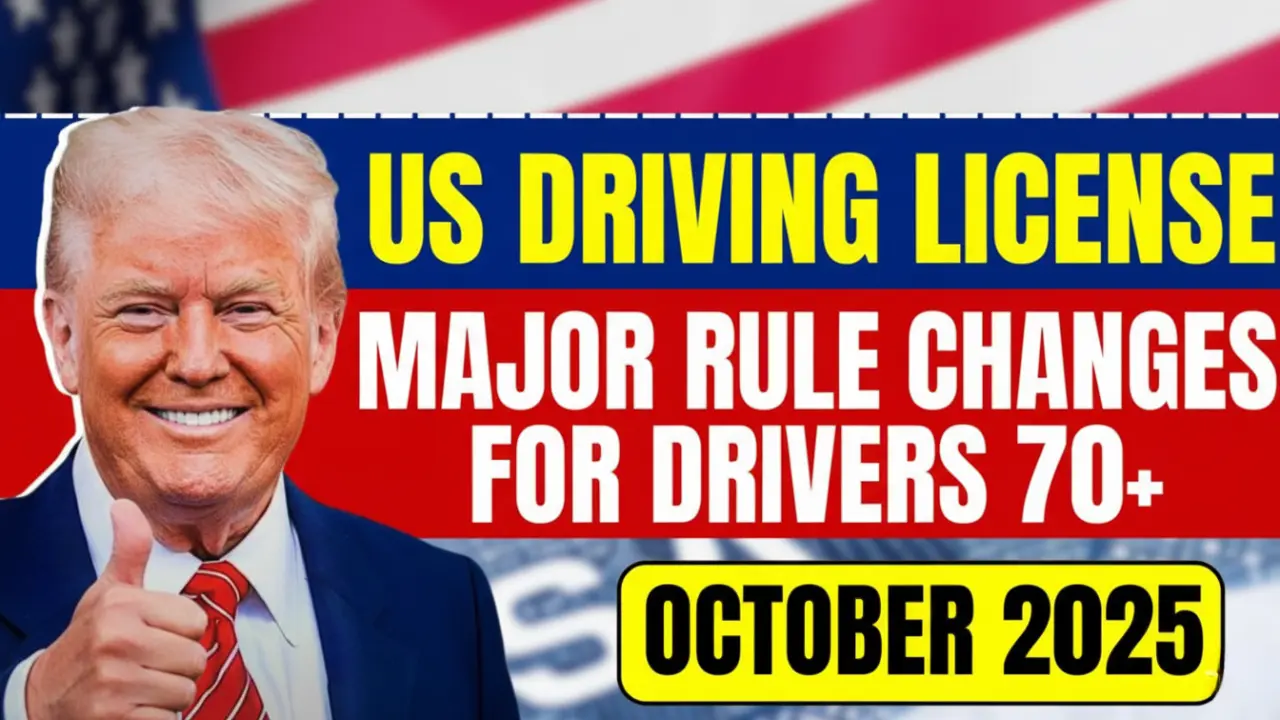In October 2025, a significant change will take effect in the United States that affects drivers aged 70 and older. This new policy, introduced by the U.S. Department of Transportation, aims to balance the safety of senior drivers with their independence. With the aging population rapidly increasing, the government has recognized the need for customized driving license renewals that reflect an individual’s capabilities rather than just their age. In this article, we will explore why this policy is necessary, its key features, and how it will affect senior drivers.
Why This Change Is Necessary
As of 2025, more than 48 million Americans aged 65 and older hold driver’s licenses. A significant portion of this group continues to lead active lives, driving themselves to various locations like grocery stores, medical appointments, and social events. However, as people age, physical and mental changes can impact their ability to drive safely. Some of the common challenges that come with aging include:
Table of Contents
- Decreased reaction time
- Weakening vision
- Diminished memory and decision-making abilities
These factors can directly affect a person’s driving skills and pose risks to both the driver and others on the road. The goal of the new policy is not to revoke driving privileges based on age, but rather to assess each individual’s ability to drive based on their specific health and functional abilities. This approach promotes road safety while maintaining seniors’ independence.
Key Features of the New Law
The most notable aspect of this new legislation is that it introduces a phased license renewal process tailored to the abilities of older drivers. This system will ensure that renewals are based on individual assessments, considering a senior’s health and driving abilities.
The age-specific renewal requirements are outlined in the table below:
| Age Group | Renewal Requirements |
|---|---|
| 70–79 years | Standard renewal with vision and reaction time testing |
| 80–86 years | In-person renewal required every 2–4 years |
| 87+ years | Annual road test and medical clearance required |
This system is designed to catch any signs of driving impairment early on and to help make driving safer for everyone. The focus is on individual assessments, ensuring that the renewal process is both fair and accurate, without penalizing seniors based solely on age.
Types of Mandatory Tests
Depending on the state and the senior driver’s health, various tests may be required to ensure they are fit to drive:
- Vision Test: This will ensure that the driver has adequate vision to safely operate a vehicle. A person’s vision, especially as they age, can significantly affect their ability to see road signs, pedestrians, and other vehicles.
- Cognitive Screening: This test will evaluate aspects such as memory, reaction time, and judgment. As people age, cognitive decline can make it difficult to make quick decisions on the road.
- Road Test: For drivers over the age of 87, or those who have health concerns, a road test will be required. This will assess whether the individual can still safely navigate traffic and follow road rules.
What Happens If a Senior Driver Is Reported?
It’s possible for a senior driver to be reported by a family member, doctor, or caregiver if there are concerns about their ability to drive safely. If a report is made, the Department of Motor Vehicles (DMV) will reassess the driver’s fitness to drive. However, it’s important to note that such reports should be based on genuine safety concerns and not personal biases.
This measure ensures that family members or caregivers who are genuinely concerned for the safety of the elderly can take appropriate action. It’s essential to address these concerns in a responsible and respectful manner to avoid unnecessary harm or conflict.
State-Specific Variations
While this policy will be implemented nationally, individual states will be responsible for applying the regulations. Some states may have stricter rules than others, taking into account their specific demographics and the needs of their residents. Below is a summary of some of the state-specific variations:
| State | Special Rules |
|---|---|
| California | In-person renewal required after age 70 |
| Florida | Vision test mandatory after age 80 |
| Texas | Annual check-in required after age 85 |
| New York | Doctor’s certificate may be required at age 80 |
These variations allow for flexibility, ensuring that the laws align with the needs of each state’s aging population.
Restricted Licenses: A Safer Option
In some cases, seniors may not need to fully stop driving, but rather, be given a restricted license. This provides a safer alternative, allowing seniors to retain some independence while ensuring road safety. The restrictions may include:
- Daytime driving only
- Driving within a specific locality
- No highway or long-distance travel
This option allows seniors to continue with their daily activities while limiting exposure to high-risk driving situations. It’s a balanced approach that considers both safety and autonomy.
What Happens If Driving Is No Longer Safe?
Not all seniors will be able to continue driving as they age. If a senior’s physical or mental condition no longer supports safe driving, alternative transportation options are available. These include:
- Ride-sharing services: Companies like Uber and Lyft offer an affordable and convenient option for seniors who can no longer drive themselves.
- Paratransit services: Many communities offer door-to-door transportation for seniors with disabilities or limited mobility.
- Volunteer driver programs: Some communities provide volunteer-based transportation services to seniors.
- Family and friend support: Often, family members will step in to help with transportation.
These alternatives ensure that seniors can still access the services and activities they need, even if they can no longer drive themselves.
A Social Perspective: The Dignity of Older Drivers
One of the most important aspects of this new policy is its respect for the dignity and independence of older drivers. Driving is often seen as a symbol of freedom and autonomy, especially for seniors. This new system does not aim to take away that freedom but instead provides a framework that allows older individuals to continue driving safely for as long as they are able. The policy respects their independence while prioritizing their safety and the safety of others on the road.
By introducing a personalized assessment approach, the government recognizes that aging is not a one-size-fits-all situation. Some seniors are fully capable of continuing to drive, while others may need additional support. This approach reflects empathy and an understanding of the unique challenges that aging brings.
Conclusion: Balancing Safety and Independence
The new driving rules for seniors, set to take effect in October 2025, represent a thoughtful balance between safety and independence. Rather than removing driving privileges based on age, the law focuses on ensuring that seniors can continue driving safely for as long as they are able. Through vision and cognitive tests, road assessments, and flexible licensing options, the policy aims to protect both senior drivers and other road users.
It’s important for all drivers to understand that these regulations are not a punishment but a means of ensuring that roads remain safe for everyone. For seniors, these new regulations offer the opportunity to maintain their independence while staying within the safety limits set by their individual capabilities.
As we approach October 2025, seniors should prepare for the new requirements and ensure that they are fit to continue driving safely. At the same time, families and caregivers can play a role in supporting their elderly loved ones through this transition, helping them navigate the new rules with respect and care.
FAQs
When will the new senior driver policy take effect?
The policy will take effect in October 2025.
Who does this new rule apply to?
It applies to drivers aged 70 and above across the United States.
Does this policy take away driving licenses from seniors?
No, it focuses on individual ability assessments, not age-based revocation.
What kind of tests will senior drivers need to pass?
Depending on their age and health, seniors may need to take a vision test, cognitive screening, and/or a road test.
Can a family member report a senior driver?
Yes, a family member, doctor, or caregiver can report concerns about a senior driver’s safety, leading to a reassessment of their driving ability.





